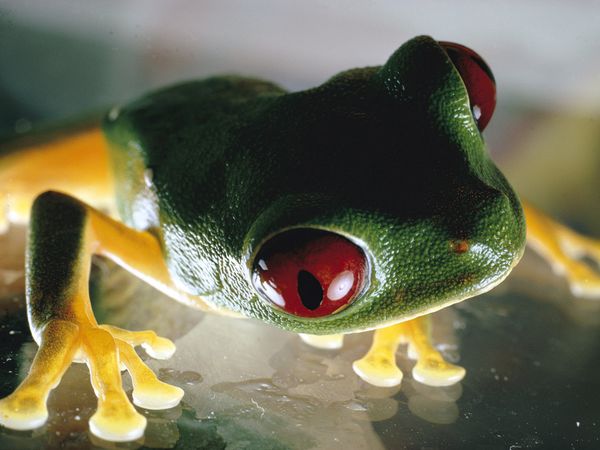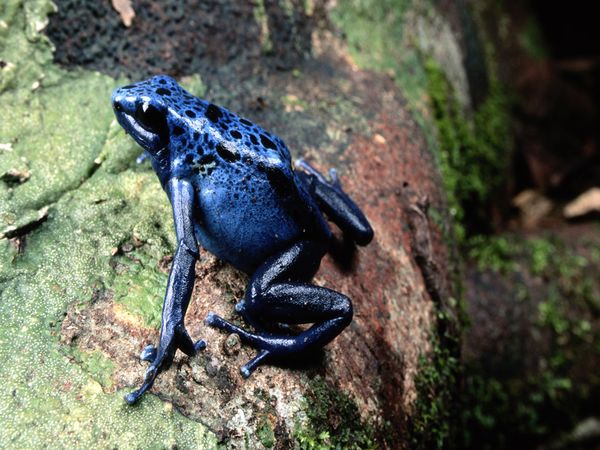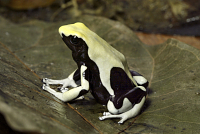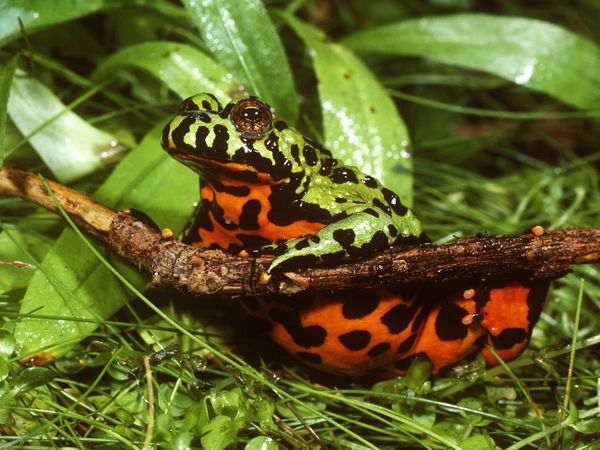
Many scientists believe the red-eyed tree frog developed its vivid scarlet peepers to schock predators into at least briefly questioning their meal choice.
These iconic rain-forest amphibians sleep by day stuck to leaf-bottoms with their eyes closed and body markings covered. When disturbed, they flash their huge, webbed orange feet and bright blue-and-yellow flanks.
Their neon-green bodies may play a similar role in thwarting predators. Many of the animals that eat red-eyed tree frogs are nocturnal hunters that use keen eyesight to find prey.
Red-eyed tree frogs, despite their conspicuous coloration, are not venomous. They are found in tropical lowlands from southern Mexico, throughout Central America, and in northern South America. Nocturnal carnivores, they hide in the rain forest conopy and ambush crickets, flies, and moths with their long, sticky tounges.
Red-eyed tree frogs are not endangered. But their habitat is shrinking at an alarming rate, and their highly recognizable image is often used to promote the cause of saving the world's rain forests.

Poison dart frogs, members of the Dendrobatidae family, wear some of the most brilliant and beautiful colors on Earth. Depending on individul habitats, which extend from the tropical forests of Costa Rica to Brazil, their coloring can be yellow, gold, copper, red, green, blue, or black. Their elaborate designs and hues are deliberately ostentatious to ward off potential predators, a tactic called aposematic coloration.
Some species display unusual parenting habits, including carring both eggs and tadpoles on their backs. Although this "backpacking" is not unique among amphibians, male poison arrow frogs are exceptional in their care, attending to the clutch, sometimes exclusively, and preforming vital transportation duties.
The two-inch-long golden poison dart frog has enough venom to kill 10 grown men. Scientist are unsure of the source of poison dart frogs' toxicity, but it is possible they assimilate plant poisons which are carried by their prey, including ants, termitesm and beetles. Poison dart frogs raised in captivity and isolated from insects in their native habitat never develope venom.
The medical research community has been exploring possible medicinal uses for some poison dart frog venom. They have already developed a synthetic version of one compound that shows promise as a painkiller.

Vibrant but toxic, poison arrow frogs range from less than an inch to two and a half inches in body length. There are more than 100 species of poison dart frogs, varying in color and pattern. Color shades vary among frogs within a species. It is the skin that contains the frog's poison.
These beautiful colors are warnings to potential predators that the frogs are poisonous. Some scientist think that the reticulated pattern of the frogs also acts as camouflage among the forest shadows. Poison dart frogs live in the rainforests of Central and South America and on a few Hawaiian islands.
Male frogs go through an elaborate ritual to attract a mate. The males vocalize, a loud trill sound, to attract females. Once the courtship ritual is completed, the females deposit dozens of eggs on leaves. The eggs are encased in a gelatinous substance for protection against decay.

Oriental fire-bellied toads secrete toxins from their skin, and they want potential predators to know it. When threatened, they rise up on their front legs and arch their back, sometimes even flipping themselves over completely, to reveal the bright red-and-black coloration of their underside. This behavior, known as the unken reflex.
One of the most common amphibians in it primary range, oriental fire-bellied toads thrive in northeastern China, Korea, southern Japan, and southern parts of Russia. They are highly aquatic and usually found in slow moving streams and ponds. When out of water, they stick to the region's coniferous and broadleaved forests. They hibernate from late September to May, sheltering in rotting logs, leaf piles, and occasionally at the bottom of streams.
Oriental fire-bellied toads are medium-sized, growing to a length of about 2 inches. Their backs, covered in spiky-looking warts, can be bright green to brownish grey, and their bellies are smooth.
Tadpoles survive on algae, fungi, and plants, while the adults eat a variety of invertebrates, including worms, insects, and mollusks.
Oriental fire-bellied are popular in the pet trade, but they are common throughout their range and have no special conservation status.